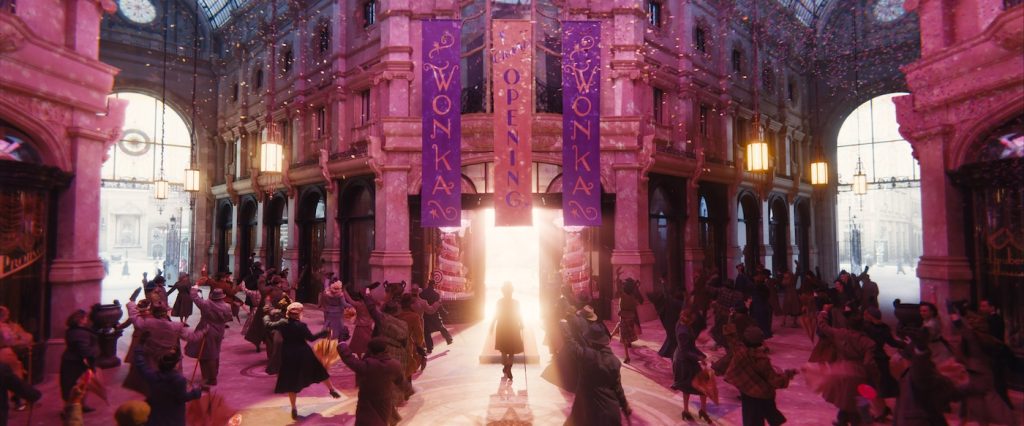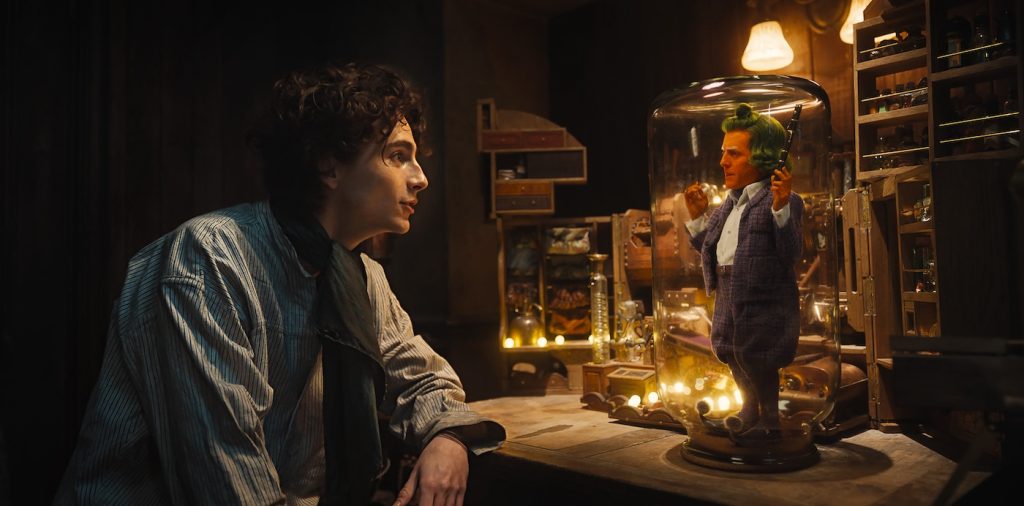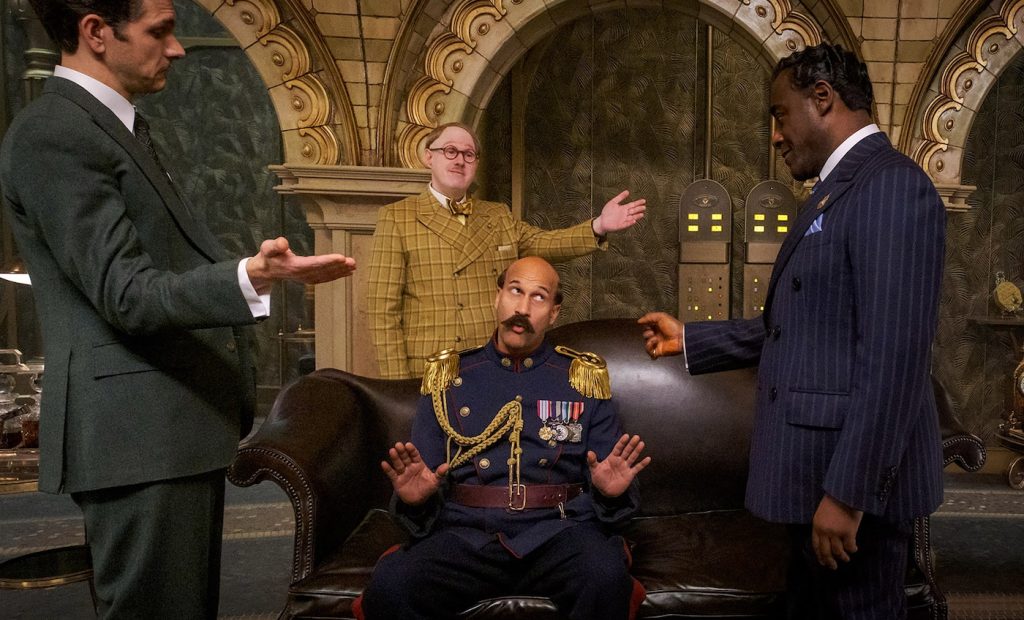“Wonka” Costume Designer Lindy Hemming on Dressing the Joyous World of a Budding Chocolatier
Costume designer Lindy Hemming knows her way around both sides of the color coin, having worked on Christopher Nolan’s texturally moody Batman trilogy and the playful palette of Paul King’s Paddington movies. She reunites with King for Wonka, whimsically outfitting the candy maker’s origins in a Gene Wilder prequel that has Dune actor Timothée Chalamet playing the title character to a joyous reaction among reviewers.
Hemming dressed a large principal cast with imaginative period aesthetics, threading bespoke looks with vibrant colors and tiny details that can only be fully appreciated upon a second viewing. A stew of burnt oranges, burgundies, yellows, greens, and blues knit the color scheme for three aristocratic chocolatiers (Paterson Joseph, Matt Lucas, Mathew Baynton ), a wretched innkeeper (Olivia Colman), an entire police force, and the iconic coat and hat of Willy Wonka. “I wanted to create a visible, instant connection to the characters. Costumes are not meant to look like costumes but pieces of wardrobe that come from somewhere,” says the Oscar winner.
The true-to-character costumes were conceptually drawn and then handmade by textile artists, costume makers, and accessory designers to ground the pitch-perfect musical. Below, Hemming shares with The Credits her color inspiration, collaborations, and the importance of dressing the crowd.
How did Paul King envision you using color for your latest collaboration?
The joy of working with Paul is that he loves color. He doesn’t just love it himself; he sees things in a colorful way, which is really quite rare. When I was younger, I didn’t see things like that, but as I’ve gotten older, I love using color. I think it is something to do with the emotions that are generated by the colors, I suppose. Paul gives you license to use colors. There are some colors he loves more than others, but he doesn’t prevent you from using color. As long as you are making a good palette, he’s happy.
How did you infuse your palette with production designer Nathan Crowley, whom you worked with on Christopher Nolan’s Batman films?
With Wonka, we’d spend every week together going through each other’s stuff. He would come to my studio, and I would go to his so I’d know what was coming. It’s much better than not knowing what the designer is up to. We are collaborators, and it was a very collaborative film in every way with the director, cinematographer, Nathan, and also all the actors. We showed the actors everything. Rooms full of reference material.
Did you want to express a thematic motif with your designs?
We really wanted to show the actors even before we started [filming] that we were having fun with the characters instead of being very serious. And I think that feeling translates into the film. The task was to have fun with color but also remain grounded in the characters. So, instead of dressing up in colors because it’s a musical, we tried to make characters who wore colors. Especially in the crowd, we wanted you to accept that it was their character dressing this way instead of a musical lineup kind of way.

How did you approach designing the clothes?
Everything on a principle character was made by us. It was all drawn beforehand, and a lot of the costumes were drawn before we knew who the actors were. Then, there was a lot of embroidery that happened. Breaking down, dying, and printing the fabrics that went into costumes like Wonka’s coat. It was either made by tailors, dressmakers, or knitted by knitters. Even the props…the rings and watches they wore were made by us. It was a big exercise in design and having the ability, thanks to the producers, to have a team that could do many different disciplines. So I have to sing praises to the technicians on the film: the knitters, embroiderers, hat makers, dyers, and fabric makers.
Speaking of Wonka, can you share what went into his look?
It started with his backstory. Where he comes from, where he’s been. You see a little bit of him living on the barge. But he also might have found his coat in a magician’s shop, and his hat might have been in the backstage box in some theater. Because he’s traveled since he was little, he kind of picked up all the pieces as he’s gone along. We wanted every bit of his costume to have a story. We worked on every such detail on all the garments.
Hugh Grant as the Oompa-Loompa was a delight. What went into fashioning his trunk of clothes?
We took part in drawing the Oompa-Loompa, and once it was decided what he was like, we had a lady who made all these big doll-sized clothes. She even made hangers and a rail in Oompa-Loompa size for his whole wardrobe to be hung up on. All the fabrics were swatched, shopped, and found. He had clothes for every kind of occasion in his trunk. And they were made to look real. Like grown-up clothes but tiny.

Another standout character is the Chief of Police, played by Keegan-Michael Key, who takes bribes in chocolate, and we see it affect his waistline as the movie progresses. How did you stylize the police force and Keegan’s character?
The costumes for the entire police force were made, and we were referencing an Eastern European costume. And for Keegan, we first drew a character that was short and fat, not tall and thin. Once Keegan came, I knew I had to draw pictures of him getting fatter and fatter for his fat suit. Honestly, it’s much funnier as a tall, thin man becoming this enormous bloke. Keegan was the most fantastic person and a really good actor.

Much of the visual energy of the musical numbers comes from the background dancers and extras. How were you able to maintain such a high level of costume detail?
The most important thing with the crowd is you need to have a wonderful team dressing and maintaining them. It doesn’t happen on many films that we get to make sure that all the people are their most interesting and the right color for scenes. And they are in front of the camera. Our first assistant director, Ben [Howard], and Paul made a rule that if we wanted to move or change someone around, we were allowed to do that. In the technical terms of making the film, it makes an enormous difference to each frame if what you’re looking at, as well as the actors are also beautiful and interesting.
Wonka dances into theaters on December 15.
Featured image: TIMOTHÉE CHALAMET as Willy Wonka in Warner Bros. Pictures and Village Roadshow Pictures’ “WONKA,” a Warner Bros. Pictures release. Courtesy Warner Bros.



